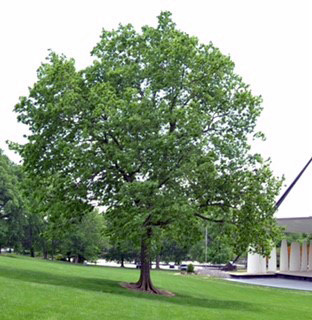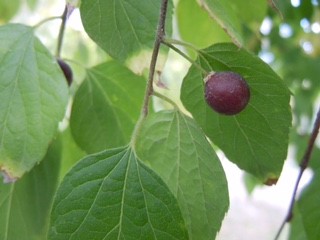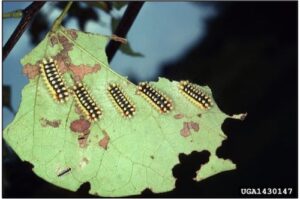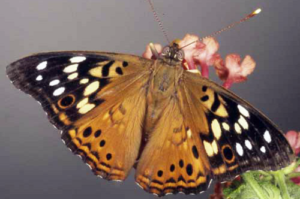Hack Your Tree Search with a Hackberry
by Susan Stager, Fairfax Master Gardener
 If you are looking for a small to medium-sized landscape tree to admire from a distance, and you don’t mind that the white to light-green colored flowers are inconspicuous, look no further than this Fairfax native, a common hackberry tree, Celtis occidentalis.
If you are looking for a small to medium-sized landscape tree to admire from a distance, and you don’t mind that the white to light-green colored flowers are inconspicuous, look no further than this Fairfax native, a common hackberry tree, Celtis occidentalis.
These hackberries can grow to 60 feet. You’ll need full sun to part shade and moist, well-drained soil. The tree is relatively problem free, tolerant to drought and native, so that local wildlife can enjoy its benefits, too.
Hackberries spread out wide at the top, or crown, of the tree, to provide lots of shade and are members of the elm family.
The flesh surrounding the large-pitted fruit turns dark red to black in September and October and remains through the winter. It reportedly tastes like honey on whole wheat toast. It especially attracts cedar waxwings and robins. Because the flesh is thin, it is hard to make much to eat out of the berries. Native Americans used them to season meat and also to bake into small cookies for energy, due to their high sugar and fat content.
The bark is grey and deeply furrowed. In fall, the leaves turn a bright yellow.

Hackberry fruit
There is a dwarf hackberry that will not grow as tall called Celtis tenuifolia. There is a Virginia State Champion dwarf hackberry on Soldier’s Hill off of Jessup Drive in Arlington Cemetery.
In the US southwest, spiny hackberry Ulmaceae Celtis ehrenbergiana is a 15 foot shrub that produces orange berries rather than dark ones. It can be spread through cultivation, into dry areas, but is not native to our area.
You will want to enjoy all these great features from a distance, rather than near your home. Wildlife will feed on the fruits, which can impact your driveway, deck and sidewalks.

Hackberry Stinging Caterpillars
Hackberries can attract a stinging caterpillar, which doesn’t hurt the tree, but can cause some people to react to a sting if they brush up against it.
A hackberry gall will disfigure the underside of the leaves of the hackberry but won’t hurt the tree. The gall is produced from a psyllium (from the Greek word for flea) feeding on the leaves. Pachypsylla feed on the hackberry and produce a number of different galls, including the hackberry nipple gall.
Witches’ brooms are messy clusters of dense, deformed twig growth and can occur in hackberry. These are produced by mites and can resemble bird nests when small.

Hackberry Emperor Butterfly
To control the mites, apply insecticidal soaps, neem oil or horticultural oils. These must be applied to the adults, who are active in the spring, because the egg stages are immune to the treatment. You’ll want to include inspecting your hackberry during your daily spring-time “coffee cup strolls” of your lawn and garden to monitor for these pests.
The hackberry emperor butterfly, Asterocampa celtis, enjoys common hackberry as a host plant. There are common hackberries in public parks throughout Fairfax, according to the iNaturalist app. If you have the room to admire a 60-foot tree, consider the hackberry, for elm-like shade, fall color, bird and butterfly watching and easily managed pest problems.
-
References
- Hackberry, Celtis occidentalis, Virginia Tech Dendrology/li>
- Dwarf hackberry, Virginia Tech Dendrology
- Spiny hackberry, Virginia Tech Dendrology
- Stinging Caterpillars: Slug Caterpillars, and Flannel Moths, Virginia Cooperative Extension, ENTO-75NP
- Galls made by Aphids, Adelgids, Phylloxerans, Psyllid and Midges, Virginia Cooperative Extension